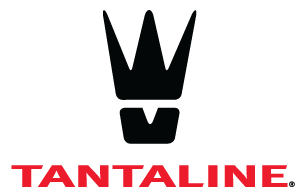What is Tantaline® Treatment
Tantaline® products consist of a core substrate (typically stainless steel) which is treated in our process to create an extremely rugged, uniform, inert and corrosion resistant tantalum surface. Through Tantaline® treatment, tantalum atoms are actually grown into the substrate creating an inseparable nanoscale surface alloy.
Further processing creates a tantalum surface of ~50 microns (0.002") with all of the characteristics and properties of pure tantalum metal. Tantaline® treatment is a gas phase process; therefore, both the internal and external surfaces of complex parts (e.g. valves, fittings, process equipment and instrumentation) can be coated.
As a result, stainless steel parts gain the superb corrosion resistance of tantalum while maintaining the mechanical properties of stainless steel, and thus far outperform specialty alloys like nickel alloys (Hastelloy®* C276, C22, B2), titanium, and zirconium.

The Tantaline® Surface
Tantaline® has developed a tantalum surface alloy treatment that is different than sprayed or dipped tantalum coatings. Designed for high performance in aggressive applications that require corrosion protection or inertness. The alloy zone is the key for Tantaline®'s rugged tantalum surface that will not chip or spall.

Surface Roughness
The Tantaline® process generally mirrors the surface roughness of the starting substrate material. Because the Tantaline® surface is grown at a molecular level it tends to slightly improve the surface finish and decrease the Ra value for standard materials.
The Tantaline® surface can achieve virtually any surface roughness as it can be polished using traditional polishing techniques.
Bond Strength of the Tantaline® surface
The bond strength of the Tantaline® surface was measured by Sturbridge Metallurgical Services. Standard bond strength test methods are utilized to measure the bond strength of ceramic coatings. Utilizing this technique, two mandrels are prepared with a 1” diameter flat surface that can be attached and pulled apart by an Instron. On one mandrel, a 316 stainless steel surface is treated with the Tantaline® Surface alloy. On the second mandrel surface, it is left as a blank 316 stainless steel surface. The mandrels are placed together end to end with a strong polyamide-epoxy adhesive (Cytex FM1000) between them and cured. Once the adhesive is cured the mandrels are pulled apart in the Instron at a specific rate to measure the PSI needed for failure.
- Baseline adhesive samples range from 10,000 - 12,000 PSI. This is the force needed to fracture the adhesive.
- Tantaline® samples: glue failed at 11,282 PSI and 12,307 PSI.
As a result, it is fair to conclude that the Tantaline® Surface has a bond strength at least as high as the baseline adhesive and could be even greater.
Thermal Cycling of the Tantaline® Surface
Samples were cycled 100x by heating in an oven to 250°C (482°F) and 300°C (572°F) and then quenched in room temperature water. After 100 cycles the samples were analyzed and compared to the baseline sample. Both sample groups are at the same magnification.
It could be seen from the cross-sections that no cracks or delamination were formed in the thermal cycled materials. The tantalum surface as well as the 316 stainless steel substrate are in excellent condition and show no signs of defects or distortion that may typically be seen on traditional coatings that are thermal cycled. This result was consistent on all samples.


Quality Control & Post-Treatment
Parts are inspected for surface integrity by placing the parts in boiling, concentrated HCl acid for 48 hours to verify that products are free from defects and have the anti-corrosive properties of pure tantalum.
After Tantaline® treatment, the parts are ball burnished (vibration polishing) in order to obtain a uniform and shiny appearance.
*Hastelloy® is a registered trademark of Haynes International
